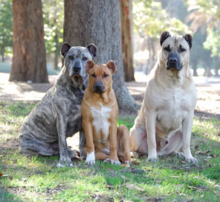| Cimarrón Uruguayo | |||||||||
|---|---|---|---|---|---|---|---|---|---|
 | |||||||||
| Other names | Cimarrón, Uruguayan Cimarrón | ||||||||
| Origin | Uruguay | ||||||||
| |||||||||
| Dog (domestic dog) | |||||||||
The Cimarrón Uruguayo (Uruguayan Cimarrón) is a breed of molosser-type dog originating in Uruguay.
Other names by which it is known in English are Cimarrón, Cimarrón Creole, Cimarrón Dog, Maroon Dog, Cerro Largo Dog, Uruguayan Gaucho Dog, Perro Cimarrón, possibly others. The breed is officially recognised in Uruguay and by the Fédération Cynologique Internationale with the name Cimarrón Uruguayo.
Appearance
The Cimarrón Uruguayo is large in size, compact and muscular. The coat is short and usually brindle but may be a pale yellow ("bayo"), with a black face. Height of males at the withers is from 58 to 61 cm (23 to 24 in) and weight is from 38 to 45 kg (84 to 99 lb). Adult females are slightly smaller.
Temperament
The breed standard states that the dog should have great courage. As with all large dogs, the Cimarrón Uruguayo must be well socialized when very young if it is to be safely kept as a companion. It is a very friendly dog with children and other animals.
The Cimarrón Uruguayo is sometimes used for guarding, hunting, and all dog sports in its native Uruguay. Being a very smart dog it has been used for all kinds of jobs, such as rescue or herding.
It is a rather calm and stable dog and doesn't usually bark unless a threat is real.
History
The Cimarrón Uruguayo mainly descends from the Alano Español and other European dogs brought by early colonizers and released or abandoned. The dogs adapted to living in the wild in Uruguay and in time became numerous. In the eighteenth century, attacks on livestock and even humans resulted in the dogs being hunted, with bounties paid by the government for each dog killed. However, many remained, especially in the highlands of Cerro Largo. Ranchers in the area would capture and tame the dogs, using them as guard dogs.
The Cimarrón's survival story and fierceness has made it something of a national symbol in Uruguay and the breed is the mascot of the National Army of Uruguay.
The Kennel Club Uruguayo (Uruguayan national kennel club) recognised the Cimarrón Uruguayo after some twenty years of work by fanciers and breeders in documenting the breed. In addition, genetic studies are being done on the breed by the Universidad de la Republica Oriental del Uruguay college of Veterinary Medicine.
The Cimarrón Uruguayo was provisionally recognised by the Fédération Cynologique Internationale on February 21, 2006, and definitively on November 7, 2017, in Group 2, Section 2 Molossoid breeds-Mastiff type. The breed has been exported to the United States, and is recognised there by the United Kennel Club in the Guardian Dog Group.

Health
The Cimarrón Uruguayo should be tested for hip and elbow dysplasia before breeding.
Often the ears are cropped short when the dogs are very young. This is alleged to be in homage to the days when they were hunted (the ears were presented for the bounty). Most fighting dog breeds have their ears cropped.
See also
References
- "Fédération Cynologique Internationale Breed Standard". Archived from the original on 2011-06-06. Retrieved 2008-10-08.
- "Cimarrón history, Kennel Club Uruguayo (in Spanish)". Archived from the original on 2008-12-19. Retrieved 2008-10-08.
- Perros Cimarrones, with photos of the dog in military parade (in Spanish)
- Government site, "The dog of Cerro Largo" (in Spanish) showing photograph of President Tabaré Vázquez holding his Cimarrón puppy
- Sociedad de Criadores de Cimarrón Uruguayo, Uruguayan breed club website Archived 2008-09-25 at the Wayback Machine
- Dogged by Dog Fights, by Katherine Watt, Vagabond, English language Bulgarian magazine. "Ear cropping is another fighting-dog feature".